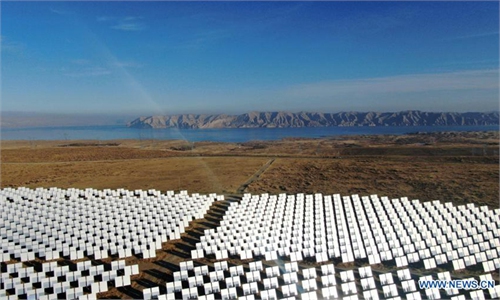
Aerial photo taken on Feb. 4, 2021 shows maintenance workers on patrol inspection along the Guozigou section of China's West-to-East Gas Pipeline in Horgos, northwest China's Xinjiang Uygur Autonomous Region. (Xinhua/Ding Lei)
A massive winter storm in the middle swath of the US forced closures at some refineries and oil fields which drove up crude prices, raising concerns of a potential impact on China's purchases of US oil covered in the phase one trade agreement that went into effect last year.
While the impact may be short-lived and limited, given that the harsh weather is likely to pass soon and production could resume, the situation provides a further example of how natural disasters such as snowstorms and the COVID-19 pandemic could pose challenges to the implementation of the phase one trade deal that is under review by the new US administration, analysts noted on Wednesday.
Following reports of closures at some of the largest refineries and shale oil fields in the US state of Texas, dubbed the US energy capital, crude prices surged, with West Texas Intermediate rising above $60 per barrel for the first time since January. The bone-chilling temperatures have curtailed US daily oil production by more than 2 million barrels and daily oil processing capacity of 3 million barrels has also been disrupted, according to Bloomberg.
While it remains to be seen how the disruptions to oil production and refining would affect China's purchase of US crude, "there may be some limited impact on the supply side," Lin Boqiang, director of the China Center for Energy Economics Research at Xiamen University, told the Global Times on Wednesday. "But I expect this impact, if there is any, would be short-lived."
Under the phase one trade agreement, China pledged to increase purchases of US products by $200 billion over a two-year period, including agricultural, manufactured and energy products. While purchases of the former two types of products have been in the spotlight, China has also been ramping up purchases of US liquefied natural gas and crude oil.
In 2020, China's imports of US crude jumped 88 percent year-on-year, according to Chinese data. With 19.76 million tons of crude exports, the US was the ninth-biggest crude supplier for China in 2020, according to media reports.
"That's actually quite small compared with China's imports from other countries. US crude has no significant advantage in price or other factors, but in line with the trade agreement, China has been buying crude," Lin said.
Despite China's increased purchases of US products, some US officials and media outlets have been claiming that China has failed to carry out its end of the bargain. The Peterson Institute for International Economics, a Washington DC-based think-tank, said that China's purchases of US crude oil only hit 45 percent of the target. The Biden administration has said it would review the deal.
But Gao Lingyun, an expert at the Chinese Academy of Social Sciences in Beijing, said that the targets are for a two-year period, rather than a yearly one, and natural disasters like the COVID-19 pandemic, which has hit the US the hardest, should be taken into consideration.
"Some have been saying that China missed the target, but this is a two-year agreement. Also many factors such as natural disasters should be considered when reviewing the progress of the agreement," Gao told the Global Times.


